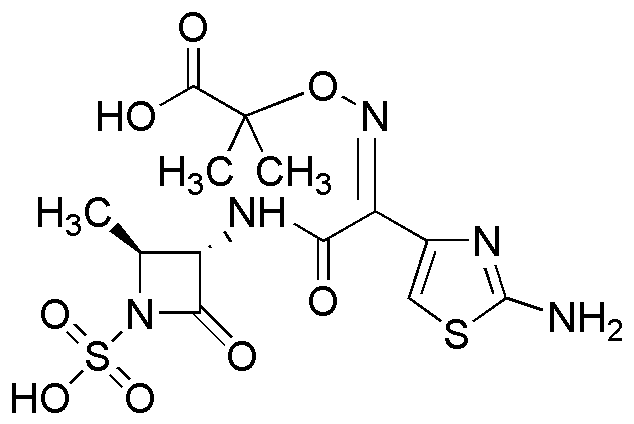Aztreonam is widely utilized in research focused on:
- Antibiotic Therapy: Primarily used to treat infections caused by Gram-negative bacteria, making it a critical option in hospitals for patients with compromised immune systems.
- Infection Control: Employed in clinical settings to manage and prevent infections in patients undergoing surgery, particularly in those at high risk for post-operative infections.
- Combination Therapy: Often used in conjunction with other antibiotics to enhance treatment efficacy, particularly in cases of multi-drug resistant bacterial infections.
- Research on Resistance Mechanisms: Valuable in studies aimed at understanding bacterial resistance, aiding researchers in developing new strategies to combat antibiotic resistance.
- Pharmaceutical Development: Serves as a model compound in the development of new antibiotics, providing insights into structure-activity relationships that can lead to more effective drugs.
General Information
Properties
Safety and Regulations
Applications
Aztreonam is widely utilized in research focused on:
- Antibiotic Therapy: Primarily used to treat infections caused by Gram-negative bacteria, making it a critical option in hospitals for patients with compromised immune systems.
- Infection Control: Employed in clinical settings to manage and prevent infections in patients undergoing surgery, particularly in those at high risk for post-operative infections.
- Combination Therapy: Often used in conjunction with other antibiotics to enhance treatment efficacy, particularly in cases of multi-drug resistant bacterial infections.
- Research on Resistance Mechanisms: Valuable in studies aimed at understanding bacterial resistance, aiding researchers in developing new strategies to combat antibiotic resistance.
- Pharmaceutical Development: Serves as a model compound in the development of new antibiotics, providing insights into structure-activity relationships that can lead to more effective drugs.
Documents
Safety Data Sheets (SDS)
The SDS provides comprehensive safety information on handling, storage, and disposal of the product.
Product Specification (PS)
The PS provides a comprehensive breakdown of the product’s properties, including chemical composition, physical state, purity, and storage requirements. It also details acceptable quality ranges and the product's intended applications.
Certificates of Analysis (COA)
Search for Certificates of Analysis (COA) by entering the products Lot Number. Lot and Batch Numbers can be found on a product’s label following the words ‘Lot’ or ‘Batch’.
*Catalog Number
*Lot Number
Certificates Of Origin (COO)
This COO confirms the country where the product was manufactured, and also details the materials and components used in it and whether it is derived from natural, synthetic, or other specific sources. This certificate may be required for customs, trade, and regulatory compliance.
*Catalog Number
*Lot Number
Safety Data Sheets (SDS)
The SDS provides comprehensive safety information on handling, storage, and disposal of the product.
DownloadProduct Specification (PS)
The PS provides a comprehensive breakdown of the product’s properties, including chemical composition, physical state, purity, and storage requirements. It also details acceptable quality ranges and the product's intended applications.
DownloadCertificates of Analysis (COA)
Search for Certificates of Analysis (COA) by entering the products Lot Number. Lot and Batch Numbers can be found on a product’s label following the words ‘Lot’ or ‘Batch’.
*Catalog Number
*Lot Number
Certificates Of Origin (COO)
This COO confirms the country where the product was manufactured, and also details the materials and components used in it and whether it is derived from natural, synthetic, or other specific sources. This certificate may be required for customs, trade, and regulatory compliance.


